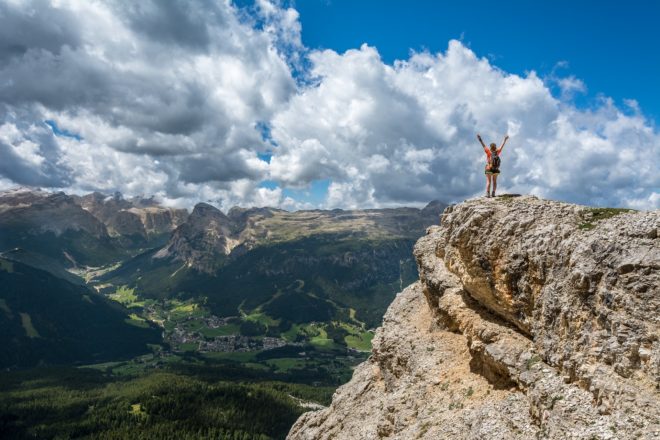Life is like climbing a mountain; you’ll get there safe and well by going at your own pace, overcoming fear and being mindful – usawa!
Usawa. What is this unusual word? It means balance in Swahili, the language spoken in beautiful Tanzania. I first discovered the mystic of “usawa” when I decided to climb Mt Kilimanjaro in August of 2010. I was 34, single, disillusioned with the medical system and highly stressed with work.
I needed answers and a new direction in life, a direction that felt real to me.
Mt. Kilimanjaro is the highest mountain in Africa, it rises above us at 5895 metres! I remember it standing majestically before me, rising deep into the clouds.
I was not an athlete, and had never climbed a mountain in my life, least of all one which literally touched the sky. So, what was I thinking?
This is what brings me here today, I want to share with all of you a few life lessons I learnt from that mountain. I carry them with me to this day, and they are:
- Steps to overcoming fear
- The necessity of mindfulness in our daily lives
- The myth that all goal seeking undoubtedly brings happiness
I remember sitting on the flight into Tanzania. I was on my own, with mixed feelings of excitement and nerves. I looked out of the window and realised the enormity of my decision. Had 12 months of training with a personal trainer been enough?
Was it true that it’s more about your mental strength than physical? Would I have enough of both? Frazzled, I cast my mind back to Matthew Syed’s book, Chance. In it, he analysed the theory that sport stars are not born, but are made.
I decided to use the technique he wrote all winning athletes use before running a race – visualisation. I knew Syed was right, but I was still a little scared and I couldn’t work out why.
What Exactly Is Fear & Why Do We Need It For Our Survival?
In life, we make decisions based on fear or love.
Fear is not knowing what the future holds. Fear makes us prepare for an upcoming test so we avoid failure, take notice when crossing the road so to avoid death, and it especially makes us train like crazy so we don’t fall sick on a mountain on our own.
Anxiety is literally fear that arises due to our thoughts jumping to the worst-case scenario. The Resilience Factor by Karin Reivich explains this beautifully and recommends an exercise which has been extremely useful for my own patients.
We naturally jump to the worst-case scenario – we tend to be programmed that way for the sake of our survival, and that’s ok.
Though, what can be incredibly hindering, is living as though the worst-case scenario is about to happen and in effect constantly living with that anxiety and fear.
Reivich explains how we can practise retraining our thinking habits by writing down our worst-case scenario, followed by the probability of that happening, then the best-case scenario, the most likely scenario and lastly, the solution to the most likely.
Then gradually, with time, our minds can switch to the most likely, rather than hanging around with the tempting and dangerous worst-case crowd.
How Do We Overcome The Unknown?
We need to work hard to familiarise our thoughts with what the future could bring us.
In my case, I researched the entire walk. I spoke to friends who were successful in making the climb; I took detailed notes about every step of the way and listened attentively to any advice they could offer.
On that 10 hour plane ride, I visualised myself climbing to the top, taking one step at a time, smiling, feeling amazing, enjoying the views, laughing. I think I must’ve gone through the story in my mind at least 100 times.
I wanted to test out Syed’s theory, and believe me – it made such a difference in my not wanting to get straight back on another 10 hour flight home!
The Climb
I remember meeting our guide for the first time. A young Tanzanian who looked incredibly confident, smartly dressed in a white t-shirt and blue shorts. “I’ve been up the mountain 400 times” he said “I will get you all up to the top.”
Though his most valuable piece of advice was – “go slow, like a snail. That’s what the mountain makes you do.” The secret to overcoming or battling the dreaded altitude sickness was to go slow, as our bodies needed to acclimatise to having less oxygen.
Mountain climbing or trekking always reminds me of mindfulness meditation; the art of decluttering the mind and being focused on one task at a time.
It takes practice, and I mean days, weeks and years of this kind of meditation to successfully be able to train the mind into slowing down. Where I was, I had no choice but to be in the present – to be completely and utterly mindful.
The mountains force you to do it. You can’t possibly think of anything else otherwise you’d lose your footing and slip and fall. One step, one foot in front of the other, will eventually lead me to my destination.
The last 1600 metres were the worst. We reached 4200m and my head began pounding, I couldn’t even eat. The last mornings’ trek was in pitch black darkness, I had to stop and catch my breath every 15 minutes as the air thinned.
One of our teammates was far worse, vomiting as often as I stopped for breath. I remember thinking to myself “am I going to die here?” Irrational, I know, but I was scared, and I couldn’t help but jump to the old ‘worst case scenario’.
Nevertheless, we kept going, out of sheer will, and eventually we did it! 5895 metres. Tears were streaming down my cheeks. I couldn’t believe I’d actually made it.
But then, before I knew it, and just 5 minutes later, we were instructed to head down. That was it, you can’t spend too long with such little oxygen.
To Set Goals, Or To Not Set Goals?
That goal, the one I’d been wishing, willing, visualising and training so hard for, had literally lasted 10 minutes. Any longer and I would’ve suffocated myself with my own wanting. It got me thinking – why?
What exactly are we trying to achieve or experience from all of this goal setting? Do we feel that the sense of achievement reflects self-worth? What is the purpose of it if, when we reach our goals, the sensation lasts just minutes before we are thinking of our next adventure?
But I realised that when reflecting on my time in Tanzania, my thoughts floated to all the wonderful moments that came from the journey, and (excuse the play on words), the climb.
I reflected on the lessons that I had learnt from the entirety of the past 6 days, not in the 10 minutes at the top – because that was where the real accomplishment was, on that mountain and in life. It’s all about what we learn. And how often now do you think I think about actually being on the top? Rarely! It was an added bonus to the story, a nice ending note.
So, it’s my opinion that goals are just guides. They can and will change, so it helps to try and see them in such a way. Your journey has been uniquely enriched with life skills which have made you into the person you are today, they’re invaluable achievements.
Now when I next think of chasing another goal to make myself feel happy, I think about what I am experiencing right now instead – the joy that I have right this moment, and I focus on being fully present.
The goals are my side projects – fun ideas that constantly require revisions, awareness, and compassion.
You can find much more information on living a holistic lifestyle in these free magazines and on our YouTube channel.
 Dr Shamistra Barathan MBBS(UK), FRACGP, ACNEM Member – Integrative General Practitioner
Dr Shamistra Barathan MBBS(UK), FRACGP, ACNEM Member – Integrative General Practitioner
Disclaimer:
This article provides general information and discussion about the medicine, health and related subjects. The words and other content provided in this article are not intended and should not be construed as medical advice. If the reader or any other person has a medical concern, he or she should consult with an appropriately licensed physician or other health care worker. The views expressed in this article have no relation to those of any academic, hospital, practice or other institution with which the author is affiliated.






